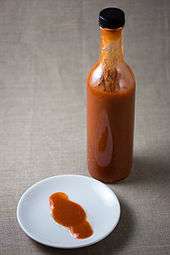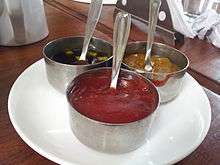Zhug
Zhug (Hebrew: סחוג), sahawiq (Yemeni Arabic: سَحاوِق) or bisbas (بسباس) is a hot sauce originating in the Yemeni cuisine.[1] In other countries of the Arabian Peninsula it is also called Mabboj (Arabic: معبوج).[2]
 Green zhug | |
| Alternative names | Harif, sahawiq, Mabboj, sahowqa, skhug |
|---|---|
| Type | Condiment |
| Place of origin | Yemen |
| Main ingredients | Hot peppers, garlic, coriander |
| Variations | Red shkug, green shkug, brown skhug |
 |
| Part of a series on |
| Arab cuisine |
|---|
|
Regional cuisines
|
|
Salads
|
|
Holidays and festivals
|
|
Etymology
The word Sahawiq comes from the Arabic root (s-ḥ-q) which means to pestle or to crush.
Varieties
Varieties in Yemen include sahawiq akhdar (green sahawiq), sahawiq ahmar (red sahawiq), and sahawiq bel-jiben (sahawiq with cheese, usually Yemeni cheese).[3] Sahawiq is one of the main ingredients of Saltah.[4] Wazif (traditional Yemeni dried baby sardines) is sometimes added to the Sahawiq's ingredients and it is known as Sahawiq Wazif (Arabic: سحاوق وزف).[5]
In Israel, one can find skhug adom ("red skhug"), skhug yarok ("green skhug") and skhug khum ("brown skhug"), which has added tomatoes. Zhug may be referred to by the generic term harif (Hebrew: חריף; lit. "hot/spicy"). Also known as zhoug,[6][7][8] it is a popular condiment at Israeli falafel and shawarma stands, and served with hummus.[9]
Preparation
Zhug is made from fresh red or green hot peppers seasoned with coriander, garlic, salt, black cumin (optional) and various spices.[10][11] Some also add caraway seed. Zhug may be red or green depending on the type of peppers used.
Traditional Yemeni cooks prepare sahawiq using two stones: a large stone called marha' (مرهى) used as a work surface and a smaller one called wdi (ودي) for crushing the ingredients. Other alternatives are a mortar and pestle or a food processor.[12] Yemenis sometimes add Pulicaria jaubertii.[13]
 Red, Green, and Smoked Zhug
Red, Green, and Smoked Zhug Skhug and its ingredients.
Skhug and its ingredients.
See also
- Arab cuisine
- Muhammara or acuka, a hot pepper dip in Levantine cuisine
- Harissa, a hot chili pepper paste in Maghreb cuisine
- Ajika, a dip in Caucasian cuisine, based on a boiled preparation of hot red peppers, garlic, herbs and spices
- Cuisine of the Mizrahi Jews
- List of dips
- List of sauces
- List of chutneys
References
- Zhug is the Yemeni hot sauce that gives a kick to your cook
- الكندري, وفاء. "المعبوج الاخضر". fatafeat.
- Various Yemeni Sahawiq varieties
- Fury, Dalton (13 May 2014). Full Assault Mode: A Delta Force Novel. St. Martin's Publishing Group. p. 176. ISBN 978-1-4668-3585-6.
- "طريقة عمل سحاوق الوزف". اكلات يمنية (in Arabic). 7 April 2018. Retrieved 31 December 2019.
- Ferguson, Gillian (4 October 2017). "What's up with all the zhoug at restaurants around town". Los Angeles Times. Retrieved 23 April 2018.
- "Where to get Auckland's best globally-influenced breakfasts". New Zealand Herald. 21 October 2017. Retrieved 23 April 2018.
- Ottolenghi, Yotam; Tamimi, Sami (2012). Jerusalem: A Cookbook. Potter/TenSpeed/Harmony. p. 301. ISBN 9781607743958.
- Red Skhug: A recipe and a story
- Goldstein, Nili (6 April 2006). "PASSOVER: Yemenite Flavor at the Seder". Tribe Media. Jewish Journal. Retrieved 23 April 2018.
- Kremezi, Aglaia (21 June 2010). "Recipe: Zhug (Yemeni Hot Sauce)". The Atlantic. Retrieved 23 April 2018.
- Janna Gur brings you the taste of Israel: Zhug
- "«السحاوق» . . طبق يمني يشتهيه الفقراء والأغنياء - البيان". www.albayan.ae (in Arabic). Retrieved 1 March 2020.

